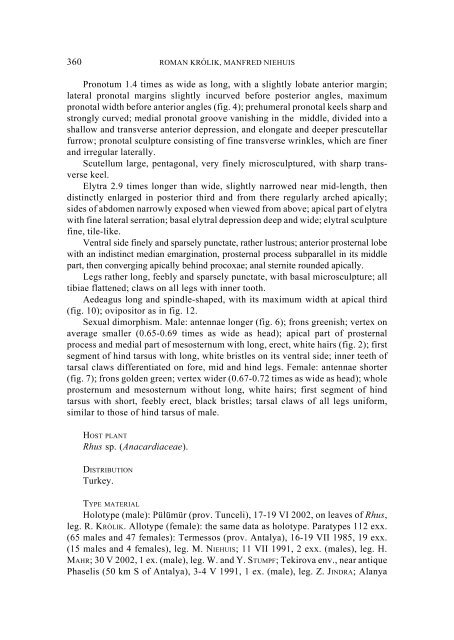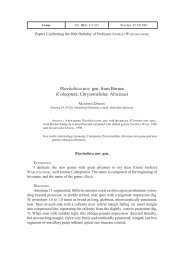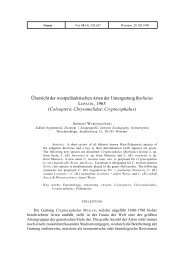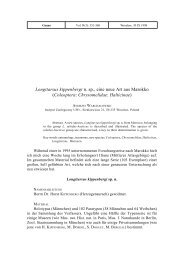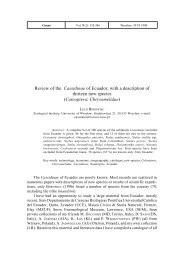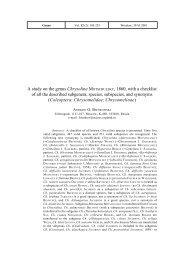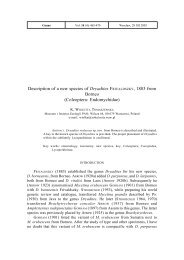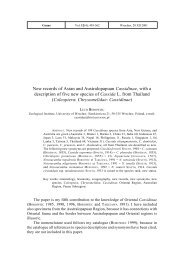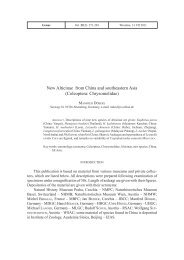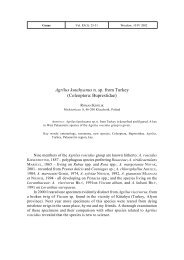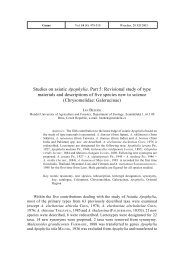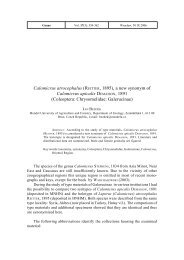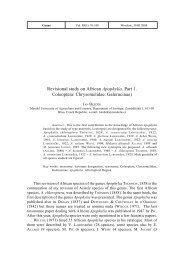Agrilus rhoos, a new species from Turkey (Coleoptera: Buprestidae)
Agrilus rhoos, a new species from Turkey (Coleoptera: Buprestidae)
Agrilus rhoos, a new species from Turkey (Coleoptera: Buprestidae)
Create successful ePaper yourself
Turn your PDF publications into a flip-book with our unique Google optimized e-Paper software.
360 ROMAN KRÓLIK, MANFRED NIEHUIS<br />
Pronotum 1.4 times as wide as long, with a slightly lobate anterior margin;<br />
lateral pronotal margins slightly incurved before posterior angles, maximum<br />
pronotal width before anterior angles (fig. 4); prehumeral pronotal keels sharp and<br />
strongly curved; medial pronotal groove vanishing in the middle, divided into a<br />
shallow and transverse anterior depression, and elongate and deeper prescutellar<br />
furrow; pronotal sculpture consisting of fine transverse wrinkles, which are finer<br />
and irregular laterally.<br />
Scutellum large, pentagonal, very finely microsculptured, with sharp transverse<br />
keel.<br />
Elytra 2.9 times longer than wide, slightly narrowed near mid-length, then<br />
distinctly enlarged in posterior third and <strong>from</strong> there regularly arched apically;<br />
sides of abdomen narrowly exposed when viewed <strong>from</strong> above; apical part of elytra<br />
with fine lateral serration; basal elytral depression deep and wide; elytral sculpture<br />
fine, tile-like.<br />
Ventral side finely and sparsely punctate, rather lustrous; anterior prosternal lobe<br />
with an indistinct median emargination, prosternal process subparallel in its middle<br />
part, then converging apically behind procoxae; anal sternite rounded apically.<br />
Legs rather long, feebly and sparsely punctate, with basal microsculpture; all<br />
tibiae flattened; claws on all legs with inner tooth.<br />
Aedeagus long and spindle-shaped, with its maximum width at apical third<br />
(fig. 10); ovipositor as in fig. 12.<br />
Sexual dimorphism. Male: antennae longer (fig. 6); frons greenish; vertex on<br />
average smaller (0.65-0.69 times as wide as head); apical part of prosternal<br />
process and medial part of mesosternum with long, erect, white hairs (fig. 2); first<br />
segment of hind tarsus with long, white bristles on its ventral side; inner teeth of<br />
tarsal claws differentiated on fore, mid and hind legs. Female: antennae shorter<br />
(fig. 7); frons golden green; vertex wider (0.67-0.72 times as wide as head); whole<br />
prosternum and mesosternum without long, white hairs; first segment of hind<br />
tarsus with short, feebly erect, black bristles; tarsal claws of all legs uniform,<br />
similar to those of hind tarsus of male.<br />
HOST PLANT<br />
Rhus sp. (Anacardiaceae).<br />
DISTRIBUTION<br />
<strong>Turkey</strong>.<br />
TYPE MATERIAL<br />
Holotype (male): Pülümür (prov. Tunceli), 17-19 VI 2002, on leaves of Rhus,<br />
leg. R. KRÓLIK. Allotype (female): the same data as holotype. Paratypes 112 exx.<br />
(65 males and 47 females): Termessos (prov. Antalya), 16-19 VII 1985, 19 exx.<br />
(15 males and 4 females), leg. M. NIEHUIS; 11 VII 1991, 2 exx. (males), leg. H.<br />
MAHR; 30 V 2002, 1 ex. (male), leg. W. and Y. STUMPF; Tekirova env., near antique<br />
Phaselis (50 km S of Antalya), 3-4 V 1991, 1 ex. (male), leg. Z. JINDRA; Alanya


